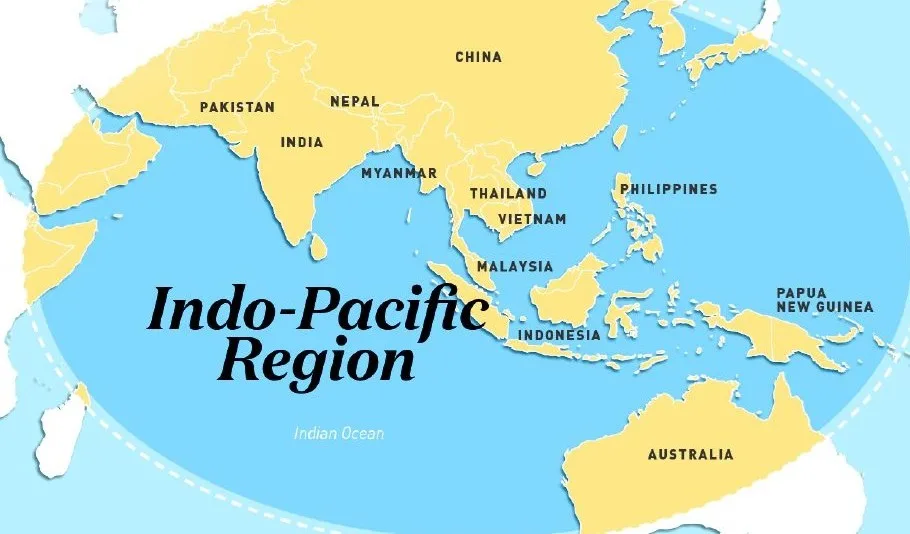Syllabus: GS2/International Relations
Context
- The Indo-Pacific region has emerged as a focal point of international diplomacy and strategic initiatives, underscoring its significance in global affairs. Nations worldwide are increasingly recognizing the importance of this region and are committing to its stability, prosperity, and openness.
About the Indo-Pacific Region
- The Indo-Pacific is a geographical area that encompasses the regions of the Indian Ocean and the Pacific Ocean, along with the countries surrounding them and the crucial waterways and marine resources.

- India’s conception of the Indo-Pacific ranges ‘from the shores of Africa to that of the Americas’ highlighting its broad and inclusive approach.
Significance of the Indo-Pacific
- Economic Hub: Over 60% of global GDP; Major trade routes of world; Strait of Malacca, Taiwan Strait, the Bab-al-Mandeb, Straits of Lombok and Sunda, the South China Sea, etc and Indian Ocean are vital arteries for energy and commerce.
- The Indian and Pacific Oceans collectively facilitate over 80% of the world’s maritime trade, including critical energy supplies.
- About 40% of global oil shipments pass through key maritime routes in the Indo-Pacific.
- 90% of India’s trade and 80% of its critical freight transit through these waters.
- Strategic Theater: The region is a geopolitical hotspot, with overlapping interests among key powers such as the United States, India, China, Japan, and Australia.
- Strategic sea lanes and territorial disputes heighten its importance.
- Diverse Stakeholders: With diverse cultures, economies, and governance systems, the Indo-Pacific represents a mosaic of opportunities and challenges. Multilateralism and regional partnerships are crucial to addressing shared concerns.
India’s Role and Commitment
- India’s commitment to the Indo-Pacific is rooted in its historic ties, strategic location, and vision of fostering a free, open, and inclusive region.
- Shangri-La Dialogue (2018) emphasized Indo-Pacific Vision as openness, ASEAN centrality, and multilateralism.
- Initiatives such as Security and Growth for All in the Region (SAGAR) underline India’s intent to strengthen maritime cooperation, ensure security, and promote sustainable development.
- Act East Policy: It underscores India’s focus on deepening engagement with Southeast Asian nations through trade, connectivity, and cultural exchanges. ASEAN remains central to India’s Indo-Pacific outreach.
- India’s support for ASEAN-led mechanisms and its active participation in regional forums like the East Asia Summit (EAS) and the Indian Ocean Rim Association (IORA) highlight its commitment to regional cooperation and stability.
- QUAD Collaboration: It is a key mechanism for advancing regional security, technology partnerships, and disaster response.
- Maritime Security: With a robust naval presence, India underscores the importance of safeguarding sea lanes, countering piracy, and promoting international law, including the United Nations Convention on the Law of the Sea (UNCLOS).
- Indo-Pacific Economic Framework (IPEF) and collaborative infrastructure projects, India aims to foster equitable development across the region.
Challenges in the Indo-Pacific
- China’s Assertiveness: Beijing’s aggressive actions in the South China Sea, Belt and Road Initiative (BRI) expansions, and strategic posturing challenge regional stability.
- China’s overseas strongpoints include Hambantota Port, Sri Lanka; Gwadar Port, Pakistan; Kyaukpyu Port, Myanmar; Ream Naval Base, Cambodia; Laem Chabang Port, Thailand; Dar es Salaam Port, Tanzania; and Logistics Facility, Djibouti etc.
- Great Power Rivalry: The strategic competition between the U.S. and China has reverberated across the Indo-Pacific, influencing the policies of regional players.
- Environmental Concerns: The region faces environmental degradation, overfishing, and climate change impacts, necessitating collective action.
- Economic Disparities: Uneven development and trade imbalances among Indo-Pacific nations require targeted interventions and equitable economic partnerships.
Global Engagements and Alliances
- United States: The US Indo-Pacific strategy emphasizes a rules-based order, economic engagement, and security cooperation.
- Japan: Japan champions its Free and Open Indo-Pacific vision, advocating for connectivity and regional prosperity.
- ASEAN’s Centrality: ASEAN’s Outlook on the Indo-Pacific emphasizes inclusivity, multilateralism, and respect for sovereignty.
- Initiatives such as the India-ASEAN Comprehensive Strategic Partnership and the Indo-Pacific Oceans’ Initiative (IPOI) are aimed at fostering economic cooperation and sustainable development.
Conclusion and Way Forward
- An enduring commitment to the Indo-Pacific requires the seamless alignment of national strategies with regional frameworks.
- India, as a pivotal player, must continue to advocate inclusivity, enhance maritime cooperation, and foster sustainable development.
- Collaborative platforms such as the Quad, ASEAN, and BIMSTEC need to be leveraged to address traditional and non-traditional security threats.
- Moreover, advancing economic integration through digital connectivity, resilient supply chains, and innovation will cement the Indo-Pacific as a hub of global opportunity.
- Environmental stewardship must also remain a cornerstone of regional policies, with an emphasis on climate resilience and green technologies.
| Daily Mains Practice Question [Q] How does India’s commitment to the Indo-Pacific region reflect its geopolitical aspirations and strategic interests in the global arena? |
Previous article
India-Indonesia: Ancient Ties to a New Phase
Next article
Semiconductor Sector Needs SOPs